The walnut, however, especially stands out with its many benefits and diverse range of uses as an ingredient.
Walnuts can typically be bought with the hard outer shell intact or removed.
The kernel, or the meat, of the walnut, lies inside the shell and contains many densely packed nutrients.
Although they are produced largely by China, the United States, Iran, Turkey, Mexico, and some others, walnuts are grown and harvested across many different regions.
They are a part of several cuisines and can also be enjoyed by themselves.
With their rich, nutty taste and reputation as a health-friendly fruit, walnuts are enjoying increasing popularity globally.
Read on to know more about walnuts and what they have to offer.
History
Walnuts, botanically known as Juglans regia, are among the first fruits or nuts that mankind consumed.
They grow on trees that are originally from Eurasia, and the region from the Balkan Peninsula to China naturally grows groves of walnut trees.
Based on archaeological findings of roasted walnut shells in the New Stone Age sites around southwestern France, there is evidence that the nut was being eaten by humans at least since around 6000 BC.
Records of walnut cultivation in Babylon exist from as long ago as 2000 BC.
However, the Ancient Greeks are said to have been the first to selectively breed and cultivate walnuts of superior size and quality, and the Romans were the ones who spread the trees that were originally from Persia – modern-day Iran and Iraq – to parts of Europe and Africa.
In the 1700s, Franciscan Fathers from Spanish missionaries brought the walnut into the United States of America.
Because of this, they were known as “mission” walnuts and were planted across Catholic facilities in the state of California.
This history, along with the mild climate and fertile land, has led to California producing almost all of the walnuts cultivated in the US today.
There are many regions of Europe, East Asia, the Mediterranean and so on where walnuts are grown commercially, with different cultivars and differing yields.
Across the thousands of years since when walnuts were first cultivated, there has been much research and farming development so that walnuts grown today have useful qualities that range from disease resistance to early ripening (2, 3).
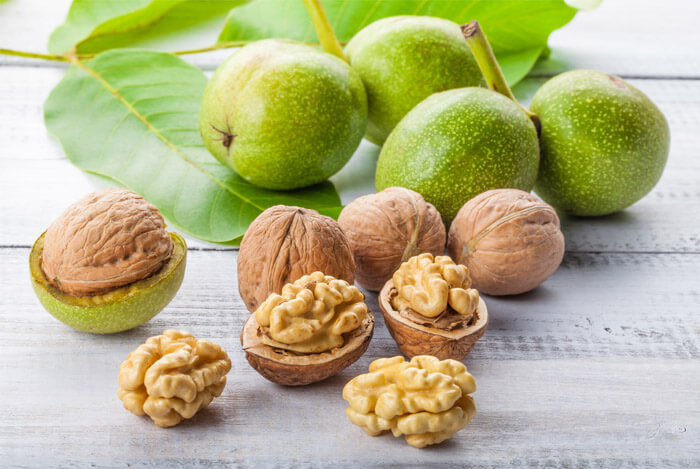
How Walnuts Grow
Walnut trees take a pretty long time to go from sown seed to mature enough to harvest.
They require fertile soil without much rock or sand and with plenty of sunlight (although they don’t thrive in a strictly warm climate and require some periods of cold).
It normally takes anywhere from five months to a year for the seeds to germinate into a plant and around another ten years before the tree is mature and producing walnuts to harvest.
A typical walnut tree will start peak production at around age 30 and will continue to produce walnuts for another 50 to 70 years.
Since the roots and leaves of walnut trees emit a toxic substance called juglone that hinders the growth of other plants nearby, it is best to give the trees ample space to grow.
These trees also have deep tap roots so there should be sufficiently rich and well-drained soil underneath to accommodate them.
Walnut plants also don’t take well to transplanting, which is why the seed should be planted right where the tree is to grow or transplanted at a very early stage.
The trees should be protected over the years from pests such as caterpillars or webworms as well as from prolonged dryness, but walnuts don’t require pruning to encourage growth.
Come harvest time, the nut with the intact husk will fall off the tree naturally.
For best results, the walnut and its shell should be removed from inside the husk as soon as this happens.
The walnut dries up inside its shell over the following several weeks if stored in a warm and dry area, after which the kernel tastes like the walnuts we usually consume.
If not shelled, the walnut will remain good for about a year after (4, 5, 6).
Varieties
The walnuts we consume regularly are mostly English, formerly Persian, walnuts, or Juglans regia.
Under the genus Juglans, however, there are around 21 different species of walnuts.
Black walnuts, known as Juglans nigra, are a variety with an earthier taste and shells that are harder to crack.
Black walnuts grow in areas across the eastern and central United States, but production and consumption are meager in comparison to regular walnuts.
Since the black walnut is native to the Unites States, it was and still is a part of many Native American diets.
Some other examples of walnut species include the Juglans cinerea – also known as white walnuts or butternut and found in the eastern United States and Southern Canada – and the Juglans ailantifolia, which is native to Japan.
Even within the range of English or Persian walnuts, there are different cultivars in production throughout the world.
These subclasses can generally be distinguished on the basis of whether the outer shell is softer or harder.
Most of these varieties come from French or American origins, and there are some other common European varieties hailing from Spain, Italy, Germany, Chile, Portugal, and so on.
The richness in taste and size of the kernel as well as the productivity, fruition, and period is taken in maturing all differ to various degrees (7, 8).
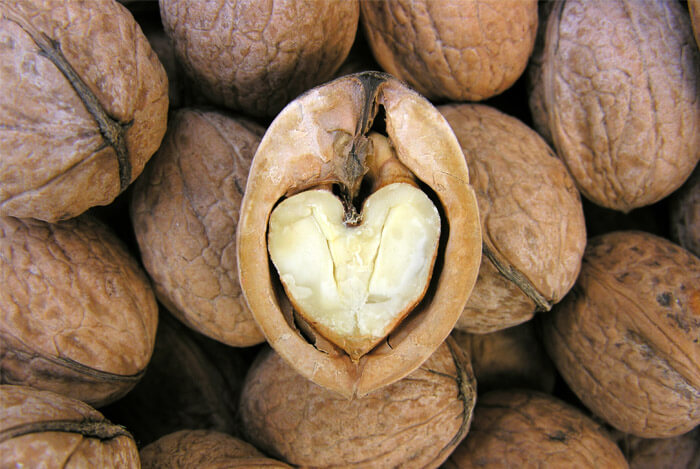
Interesting Facts
You may not have believed it before now, but there are actually lots of interesting tidbits about walnuts.
Here they are – enjoy! (9, 10, 11)
Walnuts are the oldest known tree food to mankind, dating back at least 7,000 years before the start of the current era.Not all walnut trees survive for the same number of years. While some species may live only around 50 years, some can live five times longer than that, i.e. around 250 years.
The kernel inside walnuts contains a large quantity of oil, so exposure to atmospheric oxygen turns them bitter and rancid. That is why the hard brown shells exist – they increase the shelf life of walnuts and keep them tasting and smelling fresh.
Among the different varieties, the black walnut tree has the capacity to grow the tallest and reach more than 100 feet tall.
Walnut trees are fierce about their survival! In a process known as allelopathy, their far-reaching roots release a chemical called juglone to inhibit the germination, growth, survival, and reproduction of all other organisms around them that may steal away their nutrition.
Due to their appearance, walnuts have always been linked to brain health. The outer shells resemble skulls and the kernel inside with its ridges and folds resembles a brain. While research has found that they are indeed great for the brain, walnuts have been known as “karyon,” or “head,” in Greek for a long time.
Unlike most plants, walnuts are only harvested once a year. This usually takes place in the fall, between September and November, when the husks start falling down themselves.
Walnuts, compared to other trees, can start losing their leaves quite early in the year. In fact, if you visit a walnut orchard or have a tree in your yard, you can expect leaves to cover the ground starting mid- to late summer.
While walnuts are commonly grown to be eaten, some varieties of walnuts are grown to extract their oil, which is said to be great for hair growth when applied topically. The shell of walnuts is used in making cleaning products, plastics, glues and grit paper, while the husks have long been used to make dyes. The shells and husks of the black walnut, in particular, are commonly used to dye fabrics.
The walnut tree itself is also in demand for its wood. Walnut wood is used for flooring, paneling, furniture, veneers, musical instruments and more.
Young walnut trees have green-brown bark with a smooth texture. As they age, the bark becomes gray and dull and develops deep cracks which make it rougher.
The flowers can both self-pollinate and cross-pollinate. Male flowers are in catkins, making wind pollination easier. Female flowers are spiky and arranged in clusters.
Walnuts held a lot of esteem even back in the day before their benefits were fully known. The botanical term Juglans regia translates to “Jupiter’s royal acorns” in Roman.
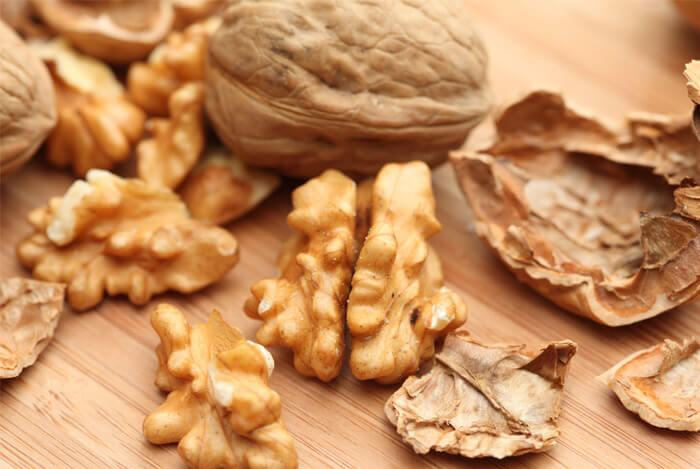
Nutritional Facts
Walnuts are one of the healthiest foods that you can eat on a daily basis.
Even within nuts, it qualifies as arguably the most nutrient-dense nut.
Walnuts have significant fat content, but don’t let this alarm you.
The fats contained in walnuts are healthy kinds that actually do you a lot of good.
Around 8 to 14 percent of the total fat content is composed of omega-3 fatty acids, also found in wild fish and some seeds and nuts, which regular diets usually lack.
Unlike other nuts that contain a lot of monounsaturated fats, walnuts also stand out because they are richer in linoleate and linoleate polyunsaturated fatty acids.
Walnuts also have a small but significant amount of protein but are low in carbs.
In one ounce of walnuts, or around 14 halves, we can usually find the following nutrients:
General:
- Calories – 183
- Fat – 18 grams
- Protein – 4 grams
- Fiber – 2 grams
- Carbs – 4 grams
- Sugars – less than 1 gram
Vitamins and Minerals:
- Manganese – 1 mg (48 percent DV)
- Cooper – 0.4 mg (22 percent DV)
- Magnesium – 44 mg (11 percent DV)
- Phosphorus – 97 mg (10 percent DV)
- Vitamin B6 – 0.2 mg (8 percent DV)
- Folate – 27 mcg (7 percent DV)
- Thiamine – 0.1 mg (6 percent DV)
DV or Percent Daily Value is a guide to indicate how much a certain amount of food will fulfill your daily nutrition needs for a particular nutrient.
This value is based on a 2,000 calorie diet for healthy adults.
Walnuts also contain a high amount of other beneficial compounds such as the antioxidants ellagic acid, catechins, melatonin and phytic acids.
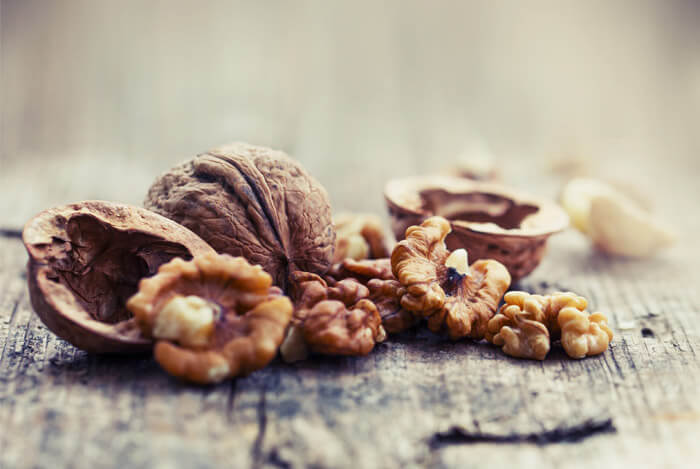
Health Benefits of Walnuts
Ward Off Depression and Anxiety
Depression is something that a lot of people deal with over the course of their lifetimes.
It is a mood disorder that involves sustained periods of despondency and dejection, coupled with feelings of helplessness and low drive to participate in regular activities.
Anxiety involves irrational nervousness and apprehension in certain situations, often resulting in panic attacks.
Although depression is more talked about and diagnosed today, it still carries an unfortunate social stigma, and there is a lot of general misunderstanding about how it operates and how it can be resolved.
For those actually suffering from depression, as well as for those around them, it is a highly draining experience with a lot of negative emotions and the diminished sense of self-worth.
Similarly, anxiety can hinder so many life opportunities.
While there may be many causes contributing to depression, chemical imbalance and dietary deficiencies may account partly for the condition.
It has been found that low levels of omega-3 fatty acids can lead to such mood and cognitive disorders, and to these two very common and life-altering conditions in particular (12, 13, 14).
Given that walnuts are so rich in omega-3s, they are bound to work well against these disorders when they are aggravated by deficiency.
In fact, it has been scientifically proven that they can (15, 16).
Not only do walnuts work for prevention, but they can also work as a cure: studies have revealed that people suffering from depression and anxiety actually enjoyed decreased symptoms after taking omega-3 supplements (17, 18, 19).
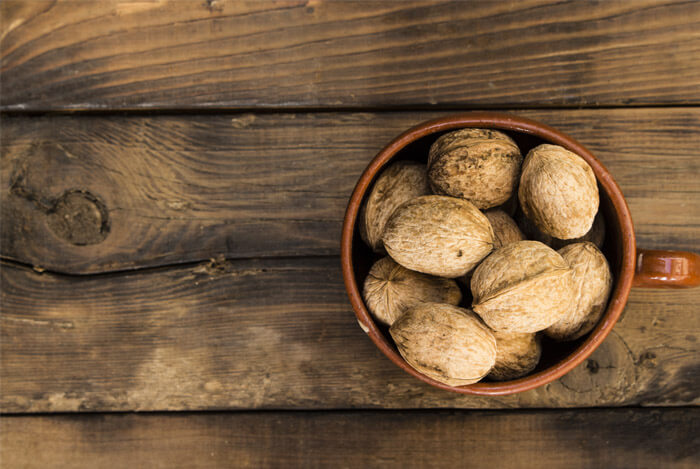
Brain Health
Placing a value on the importance of organs in the body may be pointless, given that most of them play a crucial role in our health and well-being.
Nevertheless, many would agree if we said that the brain is among the most valuable organs since it governs our every action and thoughts and is the machine behind our consciousness.
Given how precious the brain is, it makes sense to care for it from an early age as possible.
There are a bunch of nutrients in walnuts that can help boost and preserve the capacity of your brain so that you are able to enjoy the most in terms of cognition and processing information.
Neuroprotective compounds such as folate, melatonin, vitamin E, omega-3 fatty acids, and antioxidants all work in conjunction to help your brain remain young and fast.
Eating walnuts may help improve inferential reasoning or creating meaning from any form of data (20).
The results of one study suggest that antioxidants in walnuts can also help delay cognitive decline that occurs with aging by keeping your motor and cognitive functions intact through your later years (21).
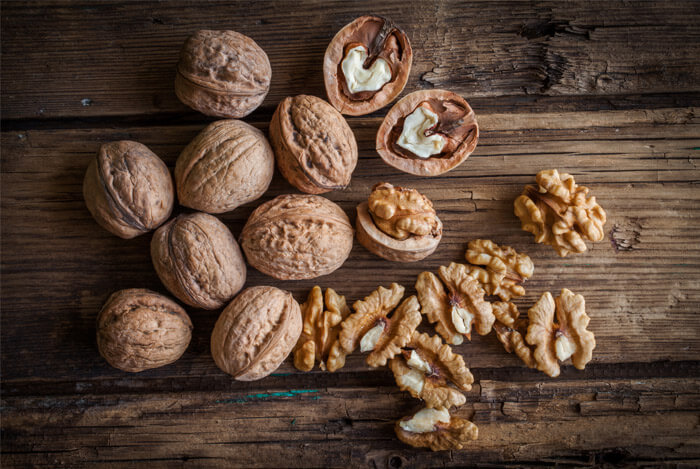
Better Memory
Whether you’re a student or a professional or neither, you must appreciate the value of having a good memory.
Memory is a great tool in learning and achieving personal growth, it helps you improve your wit, and it also helps you keep your life in order.
Forgetfulness, in general, is not something enjoyable (losing valuables or getting locked out or forgetting events may make for funny stories but not positive ones), and it can be disconcerting – especially as you grow older and try to hold on to the fragments of your past experiences.
There is evidence in scientific research that walnuts might contribute to better and longer-lasting memory.
For example, a study on the effect of walnuts on the memories and learning functions in mice showed a definite improvement on both fronts (22).
A similar study on mice with Alzheimer’s disease also proved that walnuts can actually help slow down onset decline (23).
An observational study on elderly participants also suggested that walnuts could lead to improved brain function (24).
The omega-3 content in walnuts might be a big reason why this is so since research has consistently linked it with improvements in age-related disorders such as Alzheimer’s and dementia (25, 26, 27).
Vitamin E, also present in walnuts, is also known to be effective against memory decline (28).
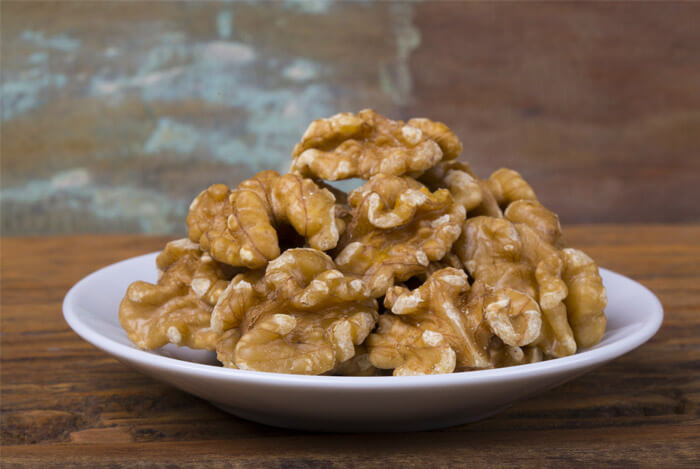
Cardiovascular Health
More of those highly important organs would be your heart and your blood vessels since any damage to either could be a matter of life or death.
Cardiovascular health is something that is emphasized often, and a big reason behind why diet and exercise are important to regulate.
While there are many different steps that you should be taking to ensure health in this area, eating walnuts can definitely contribute something to your efforts.
Studies have shown a direct relationship, with evidence that eating walnuts helps keep arteries clear of blockages, lowers inflammation and cholesterol levels, and improves overall blood circulation (29, 30, 31, 32, 33, 34, 35, 36).
Once again, Omega-3 fatty acids may be the main hero here, since they have been shown again and again to cause reductions in triglycerides (37, 38), blood pressure (39), blood clots and plaques (40, 41).
It can also raise the level of ”good” HDL cholesterol which is good for your heart (42, 43, 44).
In particular, it is the alpha-linoleic acid (ALA) which does this, and eating merely four walnuts a day can help significantly boost your ALA levels (45).
Sufficient ALA can reduce the risks of sudden cardiac death by half (Cardiovascular diseases or metabolic diseases such as diabetes are some of the biggest killers worldwide, and consuming walnuts reduces insulin resistance (47), which can be really helpful in turning things around.
You don’t even need much since only an ounce of English walnuts per day can substantially reduce cardiovascular risks (48).
Early Development
For pregnant women, the health and well-being of the developing child can be a constant concern.
Many relentlessly research the nutrients the baby requires and what danger should be avoided.
If your aim is to give the baby a head start in development, then eating walnuts during pregnancy may be a great idea.
This is because Omega-3 fatty acids are excellent for the early development of infants, inside the womb and in the first few years of a child’s life.
Walnuts contain ALA, which is converted to DHA in the body.
DHA is crucial for central nervous system development from pregnancy through the preschool years; brain growth is 70 percent complete at birth and up to 85 percent in infancy (49, 50).
For infants, who are still developing rapidly, a daily dose of walnuts for their nursing mothers may result in better vision and intelligence.
Children fed walnuts might have fewer behavioral issues, better learning, better social and interpersonal skills, and low risk of developmental delay (51, 52).
Children with a diet that includes walnuts are also more likely to be more attentive.
Omega-3 fatty acids may help treat ADHD since a deficiency is likely also a cause (53, 54).
The Omega-3s supplementation has been associated with moderately decreased impulsiveness, hyperactivity, aggressiveness and more (55, 56, 57, 58).
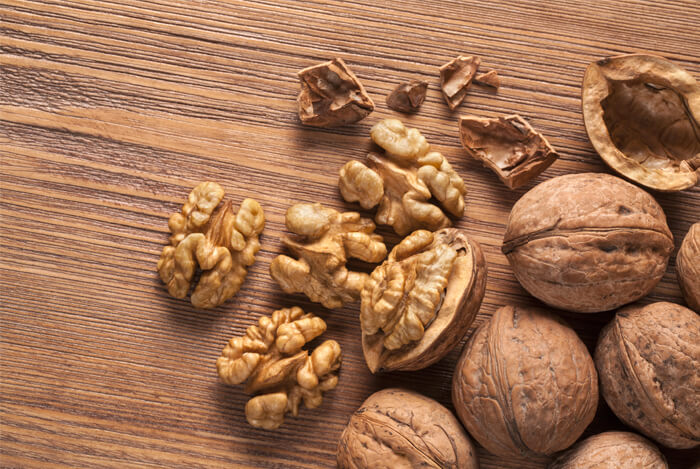
Cancer Prevention
Cancer, a malignant growth or tumor caused by the uncontrollable division of cells inside the body, is quickly becoming one of the most painful, expensive and fatal diseases on Earth.
Not only can cancer treatments be an emotional and financial drain, but patients in remission often have a high chance of suffering a similar fate again.
The exact causes and cures for the different types of cancers are still being researched by the medical and scientific community.
However, a healthy lifestyle with a nutritious diet can help prevent cancer in some cases.
Walnuts contain many antioxidants and beneficial plant compounds and have been proven effective against cancer cells and tumors in mice (59).
Bioactive components, such as polyphenols (phytosterols (61, 62), ellagic acid (63, 64) and gamma tocopherols (65), have all been shown to have anticancer properties.
Omega-3 fatty acids have also been shown to decrease risks for cancer (66, 67).
Furthermore, there is also scientific evidence that concludes that eating nuts regularly can decrease risks at least for colon and prostate cancer (68, 69).
Studies conducted on animals have largely been consistent with that finding, with successful inhibition of cancerous cells in various tissues (70, 71, 72, 73).

Weight Loss
You may think that walnuts, being both fatty and calorie-dense, would probably lead to weight gain rather than the loss.
Worry not, because although adding walnuts to your current diet will raise your calorie count, supplementing something else with walnuts will ensure that you control your weight and receive all these other wonderful benefits.
Walnuts are filling and, when eaten with meals or as a snack, can help satiate your hunger so that you don’t end up eating more than is necessary (74).
Despite being energy-rich, clinical dietary intervention studies have shown that replacing another food with walnuts does not cause weight gain (75).
A review of different trials revealed that participants who substituted nuts for other foods over time lost an extra 1.4 inches from their waists as compared to those who continued eating the less-healthy alternative (76).
While walnuts aren’t a weight loss-enhancing food in themselves, eating them properly can help you meet your goals.
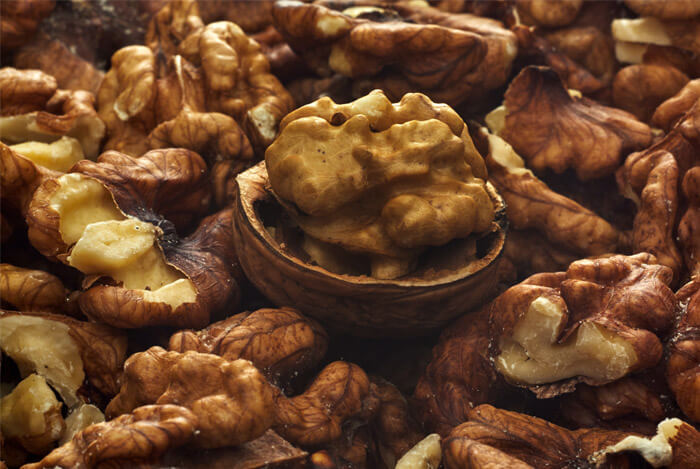
Fighting Autoimmune Disorders
Autoimmune disorders affect more than 50 million people in the United States alone.
These disorders occur when your immune system begins to attack healthy cells by forming antibodies when none are needed.
Different types can affect different tissues in the body with varying consequences; these sometimes include abnormal growth or key changes in how the organ functions.
There are more than 80 diseases under the umbrella of autoimmune disorders, including (but not limited to) celiac disease, lupus, rheumatoid arthritis, vitiligo, Hashimoto’s disease, and pernicious anemia.
The diseases may not attack with the same intensity at all times and often settle down and flare up repeatedly.
There are several studies that show that sufficient omega-3 levels can reduce the risk for diseases such as multiple sclerosis and type 1 diabetes; one particularly mentions that sufficient omega-3 levels in the first year of life decrease childhood-onset of type 1 diabetes (77, 78, 79).
Omega-3s can also diminish the symptoms of several autoimmune diseases – such as lupus, ulcerative colitis, psoriasis, Crohn’s disease, and rheumatoid arthritis – based on results from a number of studies (80, 81, 82, 83).
If you already have a diagnosed autoimmune disease, incorporating more walnuts in your diet might help you see positive results.
Healthier Skin
We all want healthy, youthful, glowing skin.
A large part of this is that culturally, and perhaps even instinctively, we value and appreciate the aesthetic elements of life.
But beyond that, a blemish-free healthy-looking appearance can raise your own confidence and help you be more yourself in all kinds of situations.
Walnuts are beneficial for your skin for several reasons.
One is that they contain several powerful antioxidants, all of which can fight free radicals, which helps maintain a youthful appearance by diminishing inflammation and visible signs of aging such as spots and wrinkles.
For example, vitamin E can strengthen capillary walls to improve moisture and elasticity in the skin, which keeps it firm to the touch.
It protects against photodamage to the skin (84) and can decrease signs of skin conditions such as acne or eczema.
Similarly, omega-3 fats help keep cell membranes healthy, regulate sebum production, keep the skin moisturized, and prevent acne, premature aging, and hyperkeratinization of hair follicles (85).
Furthermore, it can also protect your skin from sunlight by preventing the breakdown of collagen after UV rays exposure (86).
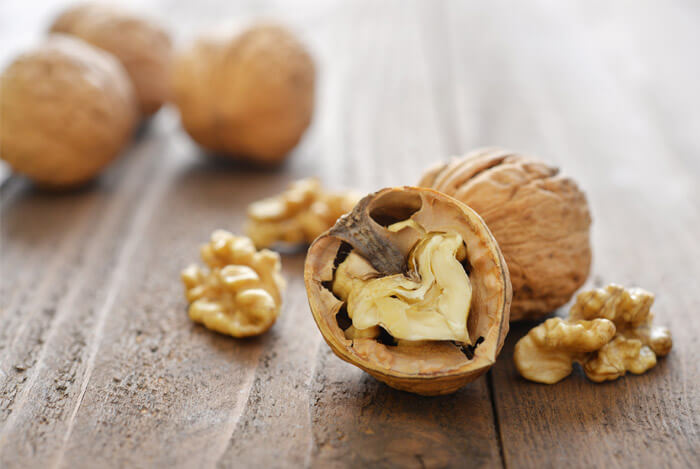
Bone Health
We often take our bones for granted, until we snap a joint and become handicapped temporarily, that is.
Our skeletal structure does a lot, from giving us the structure to protecting our organs to anchoring muscles and storing calcium.
Our bones are crucial for our mobility and without the right nutrition in our diets, they can become weak and vulnerable to injury.
This is true especially for the elderly and for postmenopausal women, who are the most susceptible to osteoporosis, the loss of bone tissue that makes bones become fragile and brittle.
Arthritis is also a common condition involving bones and is when the joints become stiff and inflamed.
However, studies have shown that omega-3 fatty acids in the diet can increase the calcium concentration in the bones and thereby make them stronger and less prone to breakage (87, 88).
Likewise, it can help arthritis symptoms, as it has been shown that patients taking extra omega-3 had increased grip strength lower joint pain over time (89, 90).
Eating walnuts from a young age will help prevent these problems in the first place given that there aren’t other conditions affecting them too.
But even those already suffering from bone-related problems may find that adding walnuts to their diet is an effective solution.
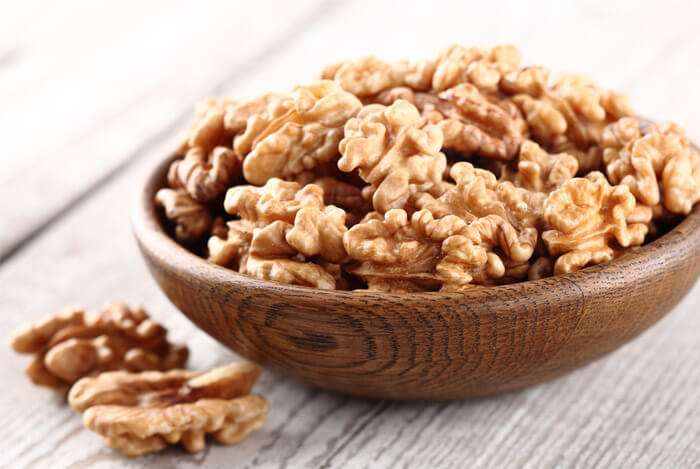
Improved Reproductive Health
A less-known and less-documented (but quite important) benefit of walnuts is that they help enhance male reproductive health.
Oftentimes, having a baby with one’s partner is a goal that seems to be out of reach. Infertility is a rampant issue and one that is usually quite emotional and upsetting.
While female infertility does account for around half of all such cases, male infertility is a bigger issue than it is made out to be; it accounts for the other 50 percent of difficulty conceiving.
The quantity and quality of sperm produced are often the reason why fertilization cannot be achieved.
A study has demonstrated that in men following a Western-style diet, eating just 75 grams of walnuts a day can lead to higher sperm count and better motility, vitality, and morphology (91, 92).
How to Buy and Store Walnuts
You may not give it too much thought when you shop for walnuts, but for the best results, there are some tips you can follow to ensure you’re enjoying the best-tasting walnuts and not spoiled ones.
When buying, it helps to know beforehand what variety you’re looking for.
Most people usually buy the English walnut for its mildly sweet taste and easy-to-crack shell.
If you have a specific subgroup you prefer, you can inquire with your store or check the packaging.
If your grocery store or another supplier consistently has old or bad walnuts, you may want to switch to somewhere else where you can get fresher produce.
The shell of the walnut helps keep it fresh for longer, so if you don’t mind cracking it open to enjoy the kernel, it is best to buy whole walnuts.
Inspect the shell and reject those that appear stained or cracked, because this could be indicative of mold inside.
Also, reject those that appear shrunken or darker than a nice light brown.
Hold the walnuts up near your ear and check to see if there’s a rattle; although it doesn’t affect the taste, a rattle will tell you that it will be easier to remove the whole kernel from the shell, which means less hard work and wastage.
If you’d rather buy shelled walnuts, check the packaging carefully for expiration information.
Walnuts with a lighter color and slightly softer texture will have a less bitter taste, and make sure that the skin of the kernel is intact since the skin holds most of the antioxidants.
When it comes to storing, keep the walnuts in a cool and dry place.
You can store them in the refrigerator if you plan to eat them soon or in the freezer if you want them to last longer.
Walnuts can absorb the smells and flavors of other foods, so don’t store them next to fruits and vegetables.
Rather, keep them in an airtight container which will keep them fresh longer and keep the flavor intact.
It helps if the container is also dark because exposure to light can also degrade the oil and make them rancid.
If you have to grind or chop walnuts for a recipe, do so just before they are needed for the freshest flavor possible (94).
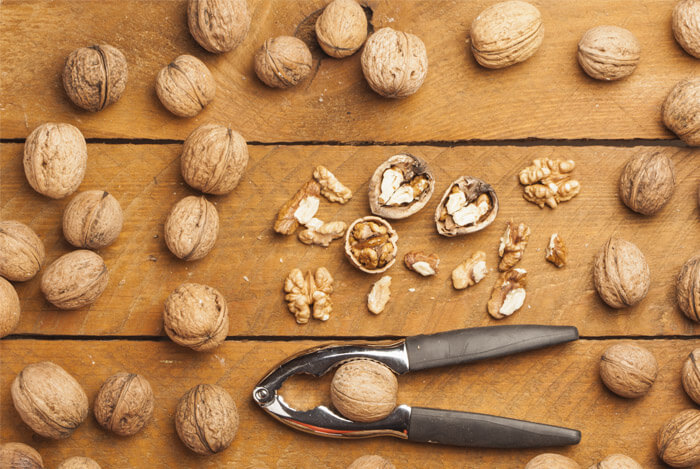
How to Incorporate More Into Your Diet
There are so many ways in which you can add walnuts to your diet – all it takes is a little effort and creativity.
One thing to keep in mind is that walnuts do contain fats (albeit largely good ones) which means that although they’re healthy, they should be consumed in moderation.
Even so, there are many ways to add walnuts to your day.
For one, you could just eat them on their own as a snack.
To enjoy the most in terms of nutrition, you could soak a handful each night and enjoy them over the next day.
A handful of walnuts and perhaps some other nuts or healthy fruits as a snack in between meals will help keep your stomach happy.
You could also use them as a part of other dishes or snacks – walnuts can enhance the flavors and eating experience of foods if you know which foods it pairs well with.
For example, you could grind walnuts up and mix them into smoothies, dips or spreads.
You could also chop walnuts up and put them into your morning cereal, such as muesli or oatmeal.
Walnuts also taste tremendous in a salad with fresh herbs or in pureed soups and pasta for some mild crunch.
Nuts are used widely in Middle Eastern and Mediterranean cuisines, so you could try world recipes involving walnuts.
Walnuts can also be used while making desserts since they pair well with ingredients like vanilla, clove, and cinnamon.
For example, baklavas or Greek yogurt parfaits can be made using walnuts.
As a versatile and delicious nut, walnuts can really be eaten in a lot of ways.
Just make a conscious effort to eat more walnuts and you will find that it’s not actually that difficult! (95, 97).
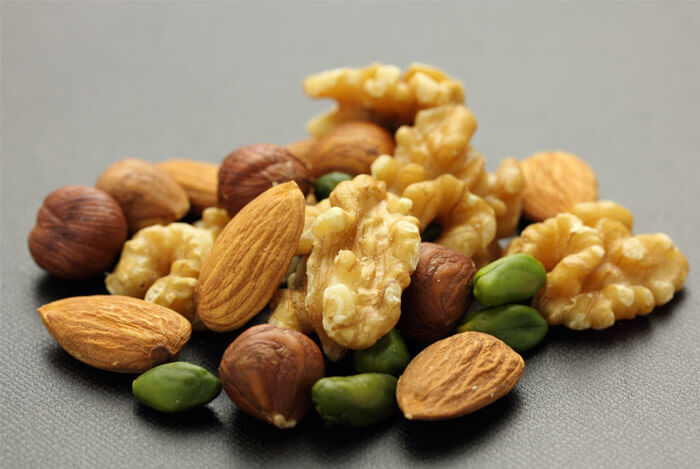
Precautions
As you’ve read above, walnuts have so many benefits to offer but, like with every good thing, there are some side effects that you should know about.
The most significant precaution for you to be aware of is that you or someone around you might be allergic to walnuts, especially since it is a tree nut (98).
You might have come across walnuts before and developed antibodies against it, which can result in sensitivity that leads to your body reacting negatively to another walnut exposure.
This type of allergy may also lead to anaphylaxis which makes it difficult to breathe and might be fatal.
You may also have secondary allergies and react poorly to walnuts because of pollen allergies and the resultant cross-reactivity due to their similar proteins (99).
Another important point to understand is that you might also suffer from tree nut allergies, which is one of the most common food allergies in the world.
If you know you have a tree nut allergy or have experienced negative physiological symptoms after coming in contact with any other tree nut (almonds, chestnuts, cashews, hazelnut, Brazil nut, macadamia nuts, pecans, pistachios, shea nuts or pine nuts) then be wary of using walnut and get tested with an allergist before trying walnuts.
If you have a peanut (which is a legume) allergy too, you may also be sensitive to tree nuts, so be careful.
The symptoms of a tree nut allergy may be something life-threating like anaphylaxis; however, you might experience less-dangerous but still-concerning symptoms such as shortness of breath, nausea, itchiness, diarrhea, difficulty swallowing, abdominal pain, cramps, nausea, vomiting, nasal congestion or a runny nose.
If you experience any of these symptoms – even on a mild level – after eating walnuts or using walnut oil, check with an allergist just to prevent a more severe reaction the next time.
Other than that, you should be aware that eating walnuts might soften your stool and cause some bloating.
Also, if you don’t reduce other unhealthy fats from your diet, it might not be helpful for weight loss and instead become counterproductive.
If your goal is weight maintenance or loss, you should substitute walnuts for other fatty foods instead of just adding walnuts to your existing diet.
Walnuts also might reduce the absorption of minerals in your digestive tract because of its phytic acid content (100); if your diet already contains other foods rich in phytic acid and low levels of minerals such as zinc and iron, then you should consider increasing your mineral uptake to compensate or soaking your walnuts, which reduces the phytic acid.
Otherwise, you may be at risk of suffering side effects of mineral deficiency.
Conclusion
Walnuts have been around for millennia on end, and they’re not going away anytime soon!
Uniquely delicious and one of the most-powerful health foods out there, walnuts have proven to the world that they’re here to stay.
Walnuts can be found either shelled or whole year-round in grocery stores around the world, so for the sake of both your taste buds and your health, it would do you a load of good to buy and eat more of them.

0Comments